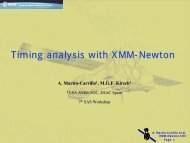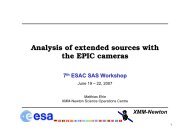RGS Bad Pixels - XMM-Newton
RGS Bad Pixels - XMM-Newton
RGS Bad Pixels - XMM-Newton
- No tags were found...
Create successful ePaper yourself
Turn your PDF publications into a flip-book with our unique Google optimized e-Paper software.
<strong>XMM</strong>-<strong>Newton</strong> CCF Release Note<strong>XMM</strong>-CCF-REL-292<strong>RGS</strong> <strong>Bad</strong> <strong>Pixels</strong>C. GabrielAugust 9, 20121 CCF componentsName of CCF VALDATE EVALDATE Blocks changed XSCS flag<strong>RGS</strong>1 BADPIX 0030 2002-11-27 2005-12-31 BADPIX NO<strong>RGS</strong>1 BADPIX 0031 2006-01-01 2007-04-08 BADPIX NO<strong>RGS</strong>1 BADPIX 0032 2007-04-09 — BADPIX NO<strong>RGS</strong>2 BADPIX 0030 2002-11-04 2005-12-31 BADPIX NO<strong>RGS</strong>2 BADPIX 0031 2006-01-01 2006-12-31 BADPIX NO<strong>RGS</strong>2 BADPIX 0032 2007-01-01 — BADPIX NO2 ChangesThis release is the product of a re-analysis of the whole data collected so far with the <strong>RGS</strong> instrumentson board <strong>XMM</strong>-<strong>Newton</strong> for extracting bad pixels/columns. In particular, we• confirm previous results related to the persistent hot columns we observe in the DiagnosticData corresponding to the last years up to 2011,• confirm in the same data the further existence of the two areas with increased offsets (”hotspots”), on both upper part sides of CCD 1 in <strong>RGS</strong>1, so each one corresponding to a readoutnode. These areas have been already flagged in previous releases of the <strong>RGS</strong> <strong>Bad</strong>pix CCFs,first as advisory hot segments, later on as uploaded bad segments. From 9 April 2007 datacorresponding to those segments in the science data are masked and not transmitted to avoidoverstressing the telemetry.• analyse the time variation of hot segments / columns throughout the mission, as observed inthe science data but not detected in the diagnostic data. While there is a certain slight increasein the number of hot stuff in the past ten years since the operational temperature of the <strong>RGS</strong>1
<strong>XMM</strong>-<strong>Newton</strong> CCF Release <strong>XMM</strong>-CCF-REL-292 Page: 2CCDs has been lowered in November 2002, the general tendency is extraordinary stable. Thecolumns flagged as advisory bad columns, to ease the data analysis making it more efficient atthe same time, have to be monitored in order not to discard them unnecessarily. A few caseshave been observed of columns being persistently hot in certain periods and then recoveringand behaving normally.In summary, we have looked for hot stuff both in diagnostic and science data between 2002 and2012, and produced a table of hot stuff per year with the aim of extending and simplifying the <strong>RGS</strong>BADPIX CCFs.3 Analysis3.1 The “hot spots”As part of the continous monitoring of the <strong>RGS</strong> instruments, offset maps are produced, as theaverages of the diagnostic images over three consecutive revolutions. They are then taken into theODF data for the offset subtraction. A significant high signal in the offset maps is an indicator fora hot pixel. <strong>Bad</strong> pixel maps are based on the relative number of any pixel found bad divided by thetotal number of exposures, ie. every pixel vary between 0 (never found bad) and 1 (always ”hot”).The two “hot spots” are clearly seen in the bad pixel maps shown in Figures 1a and 1b, containingthe averaged bad pixel maps for the whole of the year 2011. The hot spots are attributed to stressproduced in CCD1 at the bond places.Figure 1: <strong>RGS</strong>1 - CCD1 node C (left) and D (right) diagnostic bad pixel maps corresponding to2011, showing the two ”hot spots”3.2 The permanent hot columnsFigure 1b shows also the only <strong>RGS</strong>1 hot column found in the diagnostic data (column 38 of CCD 1on the D side - we define as hot columns the ones with more than 80% in the diagnostic bad pixelmap). It is known from the very early times of <strong>XMM</strong>-<strong>Newton</strong> in orbit as permanently hot and itis uploaded to on-board bad pixel rejection, therefore not telemetered. Together with another hotcolumn in the <strong>RGS</strong>2 instrument (CCD 9, column 94 of the C readout side) they represent the onlyuploaded <strong>RGS</strong> hot columns.
<strong>XMM</strong>-<strong>Newton</strong> CCF Release <strong>XMM</strong>-CCF-REL-292 Page: 58 Summary of the test resultsThe fits viewer fv was used to inspect both CCF files, wrt their structure, validity dates and contentsof the first extension (BADPIX). Everything OK.The SAS task cifbuild was run several times using data corresponding to periods covered andnot covered by these CCFs in order to check the correct selections. Selections were correctly done.The SAS task calview was used to prove that these calibration files are ingested correctly by theCAL, by pointing to the different Calibration Index Files and producing bad pixel plots.






